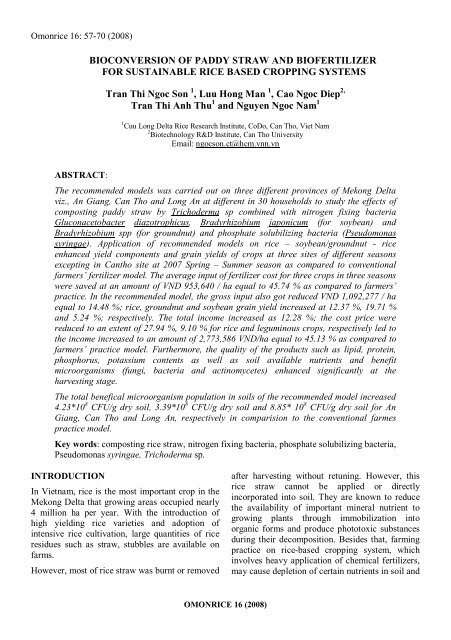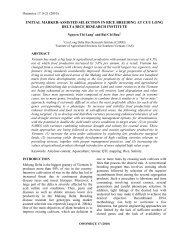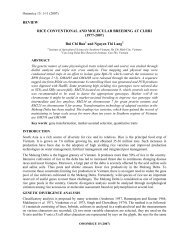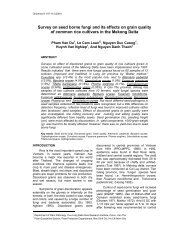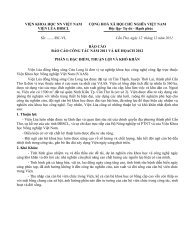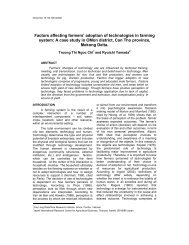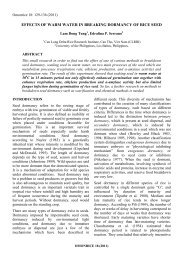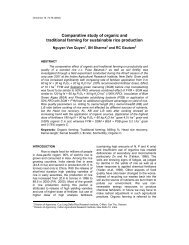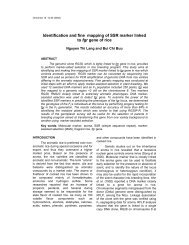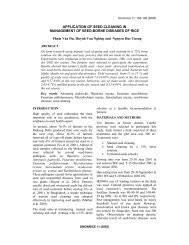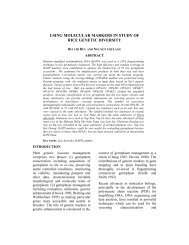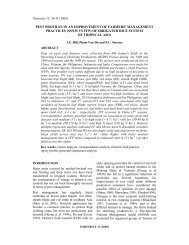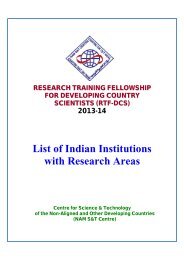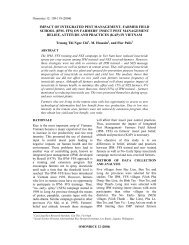BIOCONVERSION OF PADDY STRAW AND BIOFERTILIZER FOR ...
BIOCONVERSION OF PADDY STRAW AND BIOFERTILIZER FOR ...
BIOCONVERSION OF PADDY STRAW AND BIOFERTILIZER FOR ...
You also want an ePaper? Increase the reach of your titles
YUMPU automatically turns print PDFs into web optimized ePapers that Google loves.
Omonrice 16: 57-70 (2008)<br />
<strong>BIOCONVERSION</strong> <strong>OF</strong> <strong>PADDY</strong> <strong>STRAW</strong> <strong>AND</strong> BI<strong>OF</strong>ERTILIZER<br />
<strong>FOR</strong> SUSTAINABLE RICE BASED CROPPING SYSTEMS<br />
Tran Thi Ngoc Son 1 , Luu Hong Man 1 , Cao Ngoc Diep 2,<br />
Tran Thi Anh Thu 1 and Nguyen Ngoc Nam 1<br />
1 Cuu Long Delta Rice Research Institute, CoDo, Can Tho, Viet Nam<br />
2 Biotechnology R&D Institute, Can Tho University<br />
Email: ngocson.ct@hcm.vnn.vn<br />
ABSTRACT:<br />
The recommended models was carried out on three different provinces of Mekong Delta<br />
viz., An Giang, Can Tho and Long An at different in 30 households to study the effects of<br />
composting paddy straw by Trichoderma sp combined with nitrogen fixing bacteria<br />
Gluconacetobacter diazotrophicus, Bradyrhizobium japonicum (for soybean) and<br />
Bradyrhizobium spp (for groundnut) and phosphate solubilizing bacteria (Pseudomonas<br />
syringae). Application of recommended models on rice – soybean/groundnut - rice<br />
enhanced yield components and grain yields of crops at three sites of different seasons<br />
excepting in Cantho site at 2007 Spring – Summer season as compared to conventional<br />
farmers’ fertilizer model. The average input of fertilizer cost for three crops in three seasons<br />
were saved at an amount of VND 953,640 / ha equal to 45.74 % as compared to farmers’<br />
practice. In the recommended model, the gross input also got reduced VND 1,092,277 / ha<br />
equal to 14.48 %; rice, groundnut and soybean grain yield increased at 12.37 %, 19.71 %<br />
and 5.24 %; respectively. The total income increased as 12.28 %; the cost price were<br />
reduced to an extent of 27.94 %, 9.10 % for rice and leguminous crops, respectively led to<br />
the income increased to an amount of 2,773,586 VND/ha equal to 45.13 % as compared to<br />
farmers’ practice model. Furthermore, the quality of the products such as lipid, protein,<br />
phosphorus, potassium contents as well as soil available nutrients and benefit<br />
microorganisms (fungi, bacteria and actinomycetes) enhanced significantly at the<br />
harvesting stage.<br />
The total benefical microorganism population in soils of the recommended model increased<br />
4.23*10 8 CFU/g dry soil, 3.39*10 8 CFU/g dry soil and 8.85* 10 8 CFU/g dry soil for An<br />
Giang, Can Tho and Long An, respectively in comparision to the conventional farmes<br />
practice model.<br />
Key words: composting rice straw, nitrogen fixing bacteria, phosphate solubilizing bacteria,<br />
Pseudomonas syringae, Trichoderma sp.<br />
INTRODUCTION<br />
In Vietnam, rice is the most important crop in the<br />
Mekong Delta that growing areas occupied nearly<br />
4 million ha per year. With the introduction of<br />
high yielding rice varieties and adoption of<br />
intensive rice cultivation, large quantities of rice<br />
residues such as straw, stubbles are available on<br />
farms.<br />
However, most of rice straw was burnt or removed<br />
after harvesting without retuning. However, this<br />
rice straw cannot be applied or directly<br />
incorporated into soil. They are known to reduce<br />
the availability of important mineral nutrient to<br />
growing plants through immobilization into<br />
organic forms and produce phototoxic substances<br />
during their decomposition. Besides that, farming<br />
practice on rice-based cropping system, which<br />
involves heavy application of chemical fertilizers,<br />
may cause depletion of certain nutrients in soil and<br />
OMONRICE 16 (2008)
58<br />
certain others would generally accumulate in<br />
excess resulting in nutrient imbalance, which<br />
affects soil productivity and environmental<br />
pollution.<br />
Among the means available to achieve<br />
sustainability in agricultural production, suitable<br />
cropping systems, organic manure and biofertilizer<br />
play an important and key role because<br />
they possesses many desirable soil properties and<br />
exerts beneficial effect on the soil physical,<br />
chemical and biological characteristics of the soil.<br />
The result of trials on rice crop studied by CLRRI<br />
indicated that rice straw treated by Trichoderma<br />
fungi inoculant then application of composted rice<br />
straw at 6 tons/ha or in combination with different<br />
farmer’s doses of chemical fertilizer at 40, 60,<br />
80% NPK improved significantly soil<br />
microorganisms, electron transport system<br />
activities and total protein (Luu Hong Man et. al.,<br />
2003). The role of biological nitrogen fixation<br />
(BNF) in supplying plants with needed N, which<br />
can make agriculture more productive and<br />
sustainable without harming the environment, has<br />
to be efficiently harnessed. Plant growth is directly<br />
influenced by the available of reduced N, leading<br />
to the long accepted practice of manuring,<br />
fertilizer application, or rotational crop practices<br />
(Dang Kim Son, 1986; Gresshoff and Rao, 1987).<br />
Nitrogenous chemicals account for as much as<br />
30% of the total fertilizer needed for agricultural<br />
crops, with the increasing cost of chemical<br />
fertilizers and concern about environmental<br />
pollution. Studies indicate that rhizosphere, roots,<br />
stems and leaves of even healthy plants harbour<br />
diverse microbial communities that include N 2<br />
fixing bacteria as rhizobia and free living bacteria<br />
(Azotobater, Azospirillum, Herbaspirillum…) or<br />
Gluconacetobacter diazotrophicus, a promising<br />
diazotrophic endophyte (Muthukumarasamy et al.<br />
2002). The long-term field experiment on soybean<br />
conducted at Can tho showed that the quality<br />
nutrient contents and uptake of soybean with<br />
reference to N, P and K and soil available P and K<br />
were significantly improved by application of<br />
composted paddy straw and inoculants viz.<br />
Rhizobium fredii and Bradyrhizobium sp (Tran Thi<br />
Ngoc Son et al., 2003). After N, phosphorus (P) is<br />
the major plant growth-limiting nutrients despite<br />
being abundant in soils in both inorganic and<br />
Tran Thi Ngoc Son et al.<br />
organic forms. However, many soils throughout<br />
the world are P-deficient because the free<br />
phosphorus concentration (the form available to<br />
plants) even in fertile soil is not higher than 10 µM<br />
even at pH 6.5 where it is most soluble<br />
(Gyneshwar et al., 2002). To circumvent the<br />
problem of P deficiency, chemical fertilizers are<br />
added to the soils but cost of chemical phosphatic<br />
fertilizers is high (Goldstein et al., 1993) and low<br />
efficiency (
Bioconversion of paddy straw and biofertilizer for sustainable rice based cropping systems<br />
59<br />
Specific objectives<br />
1. To evaluate the effect of composted rice straw<br />
manure and biofertilizers on ricesoybean/groundnut<br />
cropping patterns under<br />
different soil type conditions<br />
2. To study the residual effect of composted rice<br />
straw manure and biofertilizers on soil fertility<br />
under rice-based cropping systems<br />
3. To determine the effects of composted rice<br />
straw manure and biofertilizers to soil<br />
microbial population under rice based cropping<br />
condition<br />
4. To assess the influence of organic and biofertilizer<br />
on soybean/groundnut under ricebased<br />
cropping system to reduce input cost and<br />
to increase economic efficiency<br />
MATERIALS <strong>AND</strong> METHODS<br />
Experiment sites<br />
Demonstrations were carried out at three provinces<br />
viz. (1) Phu Hoa village, Thoai Son district , An<br />
Giang province; (2) Truong Thanh village, Co Do<br />
district , Can tho city; (3) Tan My village, Duc<br />
Hoa district, Long An province. Two rices + one<br />
upland crop were commonly applied there.<br />
Timing<br />
1. In lightly acidic soil of An Giang province:<br />
Rice (2006 Summer-Fall) + Rice (2006-07<br />
Winter-Spring) + Soybean (2007 Spring-<br />
Summer)<br />
2. In alluvial soil of Can Tho province: Rice<br />
(2006 Summer-Fall) + Rice (2006-07 Winter -<br />
Spring) + Soybean (2007 Spring - Summer)<br />
3. In unfertile sandy soil of Long An province:<br />
Rice (2006 Summer-Fall) + Rice (2006-07<br />
Winter Spring) + Groundnut (2007 Spring-<br />
Summer)<br />
Paddy straw: paddy straw collected from 2006-07<br />
Winter Spring seasons from farmers’ fileds. It was<br />
used to produce the composted paddy straw as<br />
local organic manure. The composted paddy straw<br />
treated by fungal inoculants as Trichoderma sp.<br />
was produced by Soil Microbiology Department of<br />
CLRRI. After 30 days of composting, it was used<br />
to apply for rice crops in recommended model<br />
during 2006 Summer-Fall and 2006-07 Winter<br />
Spring season. The general process of composting<br />
as given below:<br />
FUNGAL INOCULATION (Trichoderma sp.)<br />
10-12 kg fungal inoculants<br />
<strong>PADDY</strong> <strong>STRAW</strong> (5-6 T/ha)<br />
Watering for 3-4 days/times<br />
COMPOSTED <strong>PADDY</strong> <strong>STRAW</strong><br />
(After 30 days treating)<br />
ORGANIC MANURE<br />
OMONRICE 16 (2008)
60<br />
Tran Thi Ngoc Son et al.<br />
Biofertlizers<br />
4 Fungal inoculants (Trichoderma sp.) in<br />
powder formula produced by CLRRI’s<br />
Soil Microbiology Department was<br />
applied to treat rice straw for<br />
decomposition as organic manure.<br />
5 Bioferilizers for nitrogen fixation on rice,<br />
soybean and groundnut<br />
(Gluconacetobacter diazotrophicus,<br />
Bradyrhizobium<br />
japonicum/Bradyrhizobium sp.) that<br />
produced by CLRRI’s Soil Microbiology<br />
Department and Biotechnology Research<br />
and Development Institute (BRDI), Can<br />
Tho University.<br />
6 Bioferilizers for phosphate solubilizing<br />
bacteria on soybean and groundnut<br />
cultivation (Pseudomonas syringae) that<br />
produced by BRDI, Can Tho University.<br />
Methods of inoculant production:<br />
Fungal inoculant (Trichoderma sp.) in powder<br />
formula was applied to treat into rice straw heap<br />
with adequate moisture supplying for<br />
decomposition. It took around 21 - 24 days after<br />
inoculation (2 kg/ton of rice straw); decomposed<br />
rice straw was used as organic manure<br />
Bradyrhizobium japonicum (USDA 110 strain)<br />
for soybean and Bradyrhizobium spp. (NC92<br />
strain) for groundnut are grown in the G6 medium<br />
(Singleton et al, 2002), in 4 days on rotary shaker<br />
and population reaches >10 9 cells/ml, rhizobial<br />
liquid was mixed with sterile peat at 50%<br />
moisture. Rhizobial inoculant (>10 9 cells/g) was<br />
contained in plastic bags and stored at room<br />
temperature.<br />
Pseudomonas syringae (P18 strain) was isolated<br />
from soybean rhizosphere soil and was<br />
determined high soluble phosphate and IAA. It<br />
was grown in sucrose apatite medium (Whitelaw<br />
et al, 1999) in 7 – 10 days and population reaches<br />
>10 9 cells/ml, pseudomonad liquid was mixed<br />
with the combination of sterile peat and bagasse at<br />
50% moisture and the inoculant (>10 9 cells/g) was<br />
put in plastic bags and stored at room temperature<br />
The Gluconacetobacter diazotrophicus strains<br />
isolated from roots and stems of sugar cane and<br />
determined high level of fixed nitrogen. They are<br />
grown in 10% sugar medium (Cavalcante and<br />
Dobereiner, 1988) in 4 days on rotary shaker and<br />
population reaches >10 9 cells/ml. Bacterial liquid<br />
was mixed with the mixture of sterile peat and<br />
bagasse at 50% moisture and contained in plastic<br />
bags and stored at room temperature (>10 9<br />
cells/g)<br />
Experimental demonstration model layout<br />
Field demonstrations were conducted in alluvial<br />
soil, unfertile sandy soil and lightly acidic soil<br />
conditions with the rotational system (Rice –<br />
Legume – Rice). The model experiment was<br />
arranged in two treatments<br />
* For rice cropping<br />
1 Recommended model: 6 ton composted<br />
paddy straw by Trichoderma sp. fungus +<br />
25 kg N+ 200 kg bio-fertilizers (100 kg/ha<br />
bio-phosphate fertilizer [Pseudomonas<br />
syringae] and 100 kg/ha nitrogen fixing<br />
bacteria inoculant [Gluconacetobacter<br />
diazotrophicus]) + 30 K 2 O kg/ha<br />
2 Farmers’ practices model: the fertilizer<br />
doses applied as farmers’ practices<br />
* For upland cropping<br />
The demonstration model was continued in<br />
Spring-Summer 2007 in the same 30 farmers’<br />
fields that practiced of previous rice crops. At An<br />
Giang and Can Tho provinces soybean were sown<br />
and at Long An provinces was groundnut crop<br />
after rice. The model experiment was laid out in<br />
two treatments viz. recommended practice (RP)<br />
and farmers’ practice (FP) as following:<br />
1. Recommended model: 20 kg N + 2 liters /ha<br />
bio-phosphate fertilizer [Pseudomonas<br />
syringae] + 2 liters /ha nitrogen fixing<br />
bacteria inoculant [Bradyrhizobium<br />
japonicum inoculants for soybean /<br />
Bradyrhizobium spp. inoculants for<br />
groundnut] + 30 K 2 O kg/ha<br />
2. Farmers’ practices model: the fertilizer doses<br />
applied as farmers’ practices<br />
3. Model area: 1,000 m 2 . Each kind of model<br />
was replicated for 10 times representated as<br />
OMONRICE 16 (2008)
Bioconversion of paddy straw and biofertilizer for sustainable rice based cropping systems<br />
61<br />
10 households. Total demonstration models<br />
were of 30 households from three different<br />
sites.<br />
The composted paddy straw was incorporated into<br />
soil one day prior to sowing at rate of 6 ton/ha.<br />
Soybean plants was spaced at cm intervals in 40<br />
cm rows and peanut plants at 20 cm intervals 20<br />
cm rows and legume seeds was sown in the holes<br />
and covered with mixture of rhizobial inoculants<br />
and burnt-rice husk. Potassium fertilizer as<br />
Potassium chloride (60 %K 2 O); Inorganic nitrogen<br />
fertilizer as urea (46% N); nitrogen fixing bacteria<br />
inoculant and phosphate solubilizing was<br />
broadcasted at before sowing<br />
Sample collection methods<br />
1 Rice and leguminous crops sample: Yield<br />
components and grain yield were obtained at<br />
the end of cropping season to evaluate the<br />
effects of compost and biofertilizers<br />
2 Nutrient estimation in grain content for<br />
soybean and groundnut grain consisted of<br />
total N, P 2 O 5, K 2 O and lipid content<br />
Soil samples: Soil samples was taken at the<br />
beginning and at the end of the experiment to<br />
analyse soil pH, available N, available P,<br />
exchangeable K and organic matter and microbial<br />
population (bacteria, Actinomycetes and fungi) by<br />
standard methods<br />
Economic effeciency: (i) materials (seeds,<br />
fertillizes, chemical plant protection), (ii) labour,<br />
(iii) input, (iv) income, (v) benefit recorded and<br />
evaluated.<br />
The data obtained from the present investigation<br />
were subjected to statistical scrutiny and the<br />
results were interpreted statistically.<br />
RESULTS <strong>AND</strong> DISCUSSIONS<br />
Bioconversion of paddy straw<br />
Soil Microbioly Department of CLRRI produced<br />
the composted paddy straw treated by fungal<br />
inoculants as Trichoderma sp. After 30 days of<br />
composting by this technique, it was used to apply<br />
for rice crops in recommended model during 2006<br />
Summer-Fall and 2006-07 Winter Spring seasons.<br />
The 30 households from three provinces carried<br />
out to produce the composted padd straw as<br />
organic manure, which is treated by Trichoderma<br />
sp. The bioconversion of paddy straw took place<br />
progressively through the reduction in C:N ratio.<br />
After 4- 5 weeks, the C:N ratio recorded from 18.2<br />
to 20.4. (Table 1). This is C:N ratio level was<br />
suitable to apply for rice (Fig.1)<br />
Table 1. N content, Organic carbon and C:N ratio of paddy straw manure treated by Trichoderma sp. at<br />
various timing (mean value of 30 households)<br />
Treated timing (week) N (%) C (%) C:N ratio<br />
1 0.98 38.7 39.4<br />
2 1.45 35.1 24.0<br />
3 1.46 35.6 24.4<br />
4 1.67 34.2 20.4<br />
5 1.82 33.2 18.2<br />
Source: Soil Microbiology Department of CLRRI<br />
OMONRICE 16 (2008)
62<br />
Tran Thi Ngoc Son et al.<br />
Fig. 1. Composting process of paddy straw in household<br />
a. Fungal inoculants Trichoderma sp.; b. Inoculation of Trichoderma sp. c. Watering; d. composted paddy straw<br />
Effect of paddy straw manure and biofertilizers<br />
on yield of crops at different seasons<br />
and locations:<br />
In 2006 Summer-Fall season: under<br />
recommended model, the average grain yield of<br />
rice obtained 3.77 to 4.63 T/ha. That was<br />
statistically significant difference as compared to<br />
farmers’ practice (3.43 to 3.71 T/ha) at 0.01 level<br />
in case of An Giang (T value = 4.84**) and Long<br />
An (T value = 3.86**) and at 0.05 level (T value =<br />
2.2*) in case of Can Tho. The increase in grain<br />
yield of rice due to recommended model was<br />
estimated about 9.91% to 14.28 % higher as<br />
compared to conventional practice of farmer<br />
(Fig.2)<br />
In 2006=07 Winter - Spring season: under<br />
recommended model, the average grain yield of<br />
rice obtained 4.44 to 8.18 T/ha. That was<br />
statistically significant difference as compared to<br />
farmers’ practice (3.79 to 4.91T/ha) at 0.01 level<br />
in case of An Giang (T value = 5.31**) and Long<br />
An (T value = 3.81**) and at 5% level in case of<br />
Can Tho (T value =2.34*). The increase in grain<br />
yield of rice due to recommended model was<br />
estimated about 17.15 to 35.43% (Fig.3)<br />
In 2007 Spring - Summer season:<br />
1. For soybean grain yield (at An Giang and Can<br />
Tho sites): yield from recommended model the<br />
gained from 1.77 to 2.50 T/ha, statistically<br />
significant difference as compared to farmers’<br />
practice (1.78 to 2.28 T/ha) at 1% level. T<br />
value is 2.91** in An Giang. There was no<br />
significant difference in in Can Tho (Fig. 4)<br />
2. For groundnut grain yield (at Long An site):<br />
yield from recommended practice gained 3.62<br />
T/ha, statistically significant difference as<br />
compared to farmers’ practice (3.03 T/ha) at<br />
1% level (T value = 9.13**). Grain yield of<br />
rice under recommended model was<br />
estimatedly increased 19.47 % (Fig. 4)<br />
OMONRICE 16 (2008)
Bioconversion of paddy straw and biofertilizer for sustainable rice based cropping systems<br />
63<br />
Fig . 2 . G rain yi eld of ric e in S umm e r -Au tum n 2 0 0 6<br />
T = 2 .2 0 *<br />
Grain yield (T/ha)<br />
5<br />
4<br />
3<br />
2<br />
1<br />
T = 4 .8 4 *<br />
3.7 7<br />
3 .43<br />
4.6 3<br />
4 .2 4<br />
T = 3 .86 *<br />
4 .2 4<br />
3 .7 1<br />
n= 3 0<br />
0<br />
A n G ia n g Can th o L o n g A n<br />
S ite s<br />
R eco m m e n ded p r ac t ice<br />
Fa rm e r s' p r a ct ice<br />
Fig 2. Grain yield of rice in 2006 Summer- Autunm<br />
Fig . 3 . Grain yi eld of r ic e i n W inte r- S pr ing 2 0 0 6 -2 0 0 7<br />
Grain yield (T/ha)<br />
1 0<br />
8<br />
6<br />
4<br />
2<br />
T = 5.3 1 *<br />
6 .65<br />
4 .91<br />
T = 2.3 4 *<br />
8.1 8<br />
7 .7 4<br />
T = 3 .8 1 *<br />
4 .44 3.7 9<br />
n =30<br />
0<br />
A n Giang Can tho Long A n<br />
S ite s<br />
Re co m m en de d pr act ic e<br />
F arm ers ' p rac t ice<br />
Fig 3. Grain yield of rice in 2006-07 Winter- Spring<br />
OMONRICE 16 (2008)
64<br />
Tran Thi Ngoc Son et al.<br />
Fig. 4. Grain yie ld of soybean and groundnut in<br />
Spring-Summer 2007<br />
Grain yield (T/ha)<br />
4<br />
3<br />
2<br />
1<br />
0<br />
T=9.13**<br />
3.62<br />
T=2.91*<br />
3.03<br />
*<br />
2.50<br />
T =0.43ns<br />
2.28<br />
1.77 1.78<br />
n=30<br />
An Giang Can tho Long An<br />
Sites<br />
Recomm ended pr act ice<br />
Farm ers' practice<br />
Fig 4. Grain yield of soybean and grodnut in 2007 Spring – Summer<br />
Effect of paddy straw manure and biofertilizers<br />
on microbial population at 3 different<br />
sites<br />
Soil microbial population: The obtained results<br />
recorded from two different methods of rice<br />
cultivation viz. farmers’ practice and<br />
recommended model presented in the table 1 and<br />
figure 1. In An Giang province, average soil<br />
bacterial population under recommended model<br />
was significantly recorded higher than in farmers’<br />
practice (T value = 3.38*)<br />
At Can tho site, the average soil microbial<br />
population under recommended model was<br />
significantly recorded higher than in farmers’<br />
practice (T value = 2.62*, 3.63*, 2.05* for fungi,<br />
Bacteria and Actinomycetes, respectively).<br />
At Long An site, the average soil fungi and<br />
bacteria population under recommended model<br />
were significantly recorded higher than in farmers’<br />
practice (T value = 5.37**, 4.32* for fungi and<br />
bacteria, respectively).<br />
Overall, the average microbial population under<br />
recommended model was increased 73.76, 105.9<br />
and 76.26% in An Giang, Can Tho and Long An,<br />
respectively. This results is in line with the finding<br />
of Muthukumarasamy et al (2002), Luu Hong Man<br />
et al (2003)<br />
OMONRICE 16 (2008)
Bioconversion of paddy straw and biofertilizer for sustainable rice based cropping systems<br />
65<br />
Table 2. Average soil microbial population in three different sites at harvest stage (x 10 6 CFU / 1 g of<br />
dried soil)<br />
Items Fungi Bacteria Actinomycetes Total<br />
An Giang<br />
Recommended model 0.360 675.7 321.3 997.4<br />
Farmers' practice 0.495 342.0 231.3 573.8<br />
Difference -0.135 333.7 90.0 423.6<br />
T value -1.32 ns 3.38* 1.81 ns 4.03**<br />
Can Tho<br />
Recommended model 0.495 495.5 165.2 661.2<br />
Farmers' practice 0.234 219 102 321.23<br />
Difference 0.261 276.5 63.2 339.96<br />
T value 2.62* 3.63* 2.05* 3.95**<br />
Long An<br />
Recommended model 1.394 1760.7 284.1 2046.2<br />
Farmers' practice 0.33 849.1 311.5 1160.9<br />
Difference 1.064 911.6 -27.4 885.264<br />
T value 5.37** 4.32* -0.405 ns 3.93**<br />
Source: Soil Microbiology Department, CLRRI<br />
Microbial population<br />
(*108 CFU/g of dried soil)<br />
25<br />
20<br />
15<br />
10<br />
5<br />
0<br />
20.46<br />
9.97<br />
11.61<br />
8.78<br />
5.92 5.74 6.61<br />
4.21<br />
3. 22<br />
An Gia ng Can Tho Long An<br />
Beginning<br />
Recommended<br />
model<br />
Fa rmers’<br />
prac tic es<br />
Site s<br />
Fig 5. Total microbial population at harvest stage<br />
Effect of paddy straw manure and biofertilizers<br />
on soil physico-chemical properties<br />
and grain quality<br />
Soil physico-chemical properties (table 3)<br />
Under recommeded model, soil properties were<br />
recorded higher in all parameters viz. pH, soil<br />
organic carbon, available N, P and K as compared<br />
to farmers’ practice. The average increment in pH<br />
was to the tune of 0.211 units over control at An<br />
Giang site but not in Can tho and Long An sites.<br />
This could be ascribed to the fact that the<br />
decomposition of organic wastes released Ca and<br />
Mg nutrient, which could slightly increased soil<br />
pH (Tran thi Ngoc Son and Ramaswami, 1997)<br />
Organic carbon: the higher average value was<br />
obtained under recommeded model as compared to<br />
farmers’ practice in all three locations viz. An<br />
Giang , Can Tho and Long An at harvest stage. A<br />
OMONRICE 16 (2008)
66<br />
Tran Thi Ngoc Son et al.<br />
build up of organic carbon is due to application of<br />
composted paddy straw combined with<br />
biofertilizer + 25 kg N/ha of inorganic nitrogen. It<br />
was recorded from 0.034 to 0.176 % equally to<br />
0.909 to 6.041 % as compared to farmers’ practice<br />
model. This may be due to inorganic fertilizer<br />
supplying the needed energy and nutrient for the<br />
decomposition of complex organic reserves and<br />
rapid multiplication in the soil microbial<br />
population.<br />
Available nitrogen: Marked differences were<br />
observed on soil available nitrogen due to different<br />
practices. The higher soil N value was observed<br />
under recommended model as compared to<br />
farmers’ practice from 5.78 to 19.467 pppm. This<br />
was due to the inherent N content of the<br />
composted paddy straw incorporated and<br />
transformation during composting and after<br />
application into the soil nitrogen fixing bacteria<br />
viz. Gluconacetobacter diazotrophicus,<br />
Bradyrhizobium japonicum. This is in agreement<br />
with the previvious finding of Tran thi Ngoc Son<br />
et al. 2006.<br />
Available P: was also found to be increased to an<br />
extent of 0.38 to 2.18 ppm under recommended<br />
model as compared to farmers’ practice equal to<br />
an increment of 96.46%, 72.73% and 3.49 % in An<br />
Giang, Can Tho and Long An, respectively.<br />
Organic acids released during decomposition of<br />
organic influences the pH from stable complexes<br />
or chelates with cations responsible from P<br />
fixation as well as the phosphate solublizers viz.,<br />
Pseudomonas and in turn, increased P availability<br />
application of biofertilizers significantly reduced<br />
the fixation of added as well as native P, making P<br />
more available to plant. This resut supports the<br />
findings of many workers (Tran thi Ngoc Son and<br />
Ramaswami, 1997; Gyaneshwar, et al., 2002)<br />
Available K: was also found to be influenced by<br />
different cultural practices. It was obtained higher<br />
value to an extent of 4.6 to 7.0 ppm under<br />
recommended model as compared to farmers’<br />
practice. These increments were equal to 12.46%,<br />
6.53% and 8.16 % in An Giang, Can Tho and<br />
Long An, respectively<br />
Table 3. Average soil nutrient availability of crops at 3 sites at harvest stage under different cultural<br />
practices<br />
Parameters Locations An Giang Can Tho Long An<br />
pH RM (1) 4.938 5.07 5.88<br />
FP (2) 4.727 5.29 5.99<br />
(1)-(2) 0.211 -0.22 -0.11<br />
% increase 4.464 -4.159 -1.836<br />
OC (%) RM (1) 3.774 3.948 1.650<br />
FP (2) 3.740 3.772 1.556<br />
(1)-(2) 0.034 0.176 0.094<br />
% increase 0.909 4.666 6.041<br />
N (ppm) RM (1) 27.78 29.53 16.92<br />
FP (2) 16.84 10.063 11.14<br />
(1)-(2) 10.94 19.467 5.78<br />
% increase 64.96 193.5 51.89<br />
P (ppm) RM (1) 4.44 4.94 11.28<br />
FP (2) 2.26 2.86 10.90<br />
(1)-(2) 2.18 2.08 0.38<br />
% increase 96.46 72.73 3.49<br />
K (ppm) RM (1) 63.2 75.0 71.6<br />
FP (2) 56.2 70.4 66.2<br />
(1)-(2) 7.00 4.60 5.40<br />
% increase 12.46 6.53 8.16<br />
Source: Soil Science Department, CLRRI, (1) Recommended model; (2) Farmer’s practice<br />
OMONRICE 16 (2008)
Bioconversion of paddy straw and biofertilizer for sustainable rice based cropping systems<br />
67<br />
Effect of paddy straw and biofertilizer grain<br />
quality and uptake<br />
1. Protein and lipid content in groundnut grain:<br />
The mean value of protein content in<br />
groundnut grain under recommended practice<br />
was recorded higher (due to the application of<br />
biofertilizer) than farmer practice. The protein<br />
content in grain in recommended model<br />
increased 13.85% as compared with farmers’<br />
practice. The mean value of lipid content in<br />
recommended model was higher 3.23% than<br />
farmers’ practice (Fig. 6)<br />
2. Treatmental influence on N uptake by<br />
soybean grain (Fig.7): N uptake by soybean<br />
grain was found to be influenced by the<br />
different treatments. At An Giang site, the<br />
mean value of N uptake (kg/ha) was recorded<br />
higher value (158 kg/ha) to an amount of<br />
8.96% than farmers’ practice (145 kg/ha).<br />
This is in accordance with the findings of<br />
many workers (Galal, 1997; Araujo and<br />
Teixeira, 2003, Tran thi Ngoc Son et al. 2004)<br />
Content (%)<br />
50<br />
40<br />
30<br />
20<br />
10<br />
Fig.6 Grain quality of groundnut<br />
Fig. 7<br />
24.66<br />
21.66<br />
45.34 43.92<br />
Protein (%) Lipid (%)<br />
Grain quality<br />
Recommended practice<br />
Farmers' practice<br />
N uptake<br />
(kg/ha)<br />
1 70<br />
1 30<br />
90<br />
50<br />
N uptak e in S oybean g rain at<br />
An Giang and C an tho s ites<br />
158<br />
145<br />
A n Gian g<br />
Grain quality<br />
112 115<br />
Can th o<br />
Reco m m en ded p ract ice<br />
Farm ers' p ract ice<br />
Fig. 6 . Grain quality of groundnut Fig. 7 . N uptake in soybean grain at An Giang and Can Tho sites<br />
Effect of paddy straw manure and biofertilizers<br />
on economic efficiency (Table 4)<br />
In 2006 Summer-Fall: Total average input cost<br />
under recommended model was recorded lower as<br />
VND 1,360,000; 1,147,000 and 1,313,000 / ha as<br />
compared to farmers’ practice in An Giang, Can<br />
Tho and Long An, respectively.<br />
The benefit: under recommended model, the<br />
average gross return recorded as VND 9,050,000<br />
to 11,114,000 / ha while under farmers’ practice,<br />
this one only ranged from VND 8,224,000 to<br />
10,174,000 / ha.<br />
In 2006-07 Winter- Spring: Total average input<br />
cost under recommended model was recorded as<br />
VND 1,232,000; 1,040,000 and 890,000 / ha as<br />
compared to farmers’ practice in An Giang, Can<br />
Tho and Long An, respectively.<br />
The benefit: under recommended model, the gross<br />
benefit recorded as VND 5,336,000 to 17,336,00 /<br />
ha while under farmers’ practice, this one only<br />
ranged from VND 2,823,000 to 15,097,000 / ha.<br />
In 2007 Spring- summer: Total average input<br />
cost under recommended model was recorded the<br />
lower value as VND 1,289,000; 1,100,000 and<br />
459,000 / ha as compared to farmers’ practice in<br />
An Giang, Can Tho and Long An, respectively.<br />
The benefit: under recommended model, the gross<br />
benefit recorded as VND 3,895,000 to 15,433,00 /<br />
ha while under farmers’ practice, this one only<br />
ranged from VND 2,855,000 to 9,980,000 / ha.<br />
Generally, the increase by recommended practice<br />
obtained higher benefit as 36.1%, 36.42% and<br />
54.64 % as compared to farmers’ practice in An<br />
Giang, Can Tho and Long An, respectively. That<br />
implied that the practice is acceptable according to<br />
the economic opinion and regulation.<br />
OMONRICE 16 (2008)
68<br />
Tran Thi Ngoc Son et al.<br />
Table 4: Mean value of economic efficiency of crop production under different practice (x VND 1,000<br />
/ha)<br />
2006 2006-07 2007<br />
Total<br />
Summer- Fall Winter- Spring spring- summer<br />
Items RM<br />
(1)<br />
FP<br />
(2)<br />
RM<br />
(1)<br />
FP<br />
(2)<br />
RM<br />
(1)<br />
FP<br />
(2)<br />
RM<br />
(1)<br />
FP<br />
(2)<br />
Benefit<br />
from 3<br />
seasons<br />
An Giang<br />
Input 3,921 5,281 6,576 7,808 6,452 7,741 16,949 20,830 -3,881<br />
Gross return 9,050 8,224 16,303 13,461 16,986 15,477 42,339 37,162 5,177<br />
Benefit 5,129 2,943 9,727 5,653 10,534 7,736 25,390 16,332 9,058<br />
Can Tho<br />
Input 4,579 5,726 5,189 6,229 7,548 8,648 17,316 20,603 -3,287<br />
Gross return 11,114 10,174 22,525 21,326 11,443 11,503 45,082 43,003 2,079<br />
Benefit 6,535 4,448 17,336 15,097 3,895 2,855 27,766 22,399 5,367<br />
Long An<br />
Input 3,699 5,012 5,743 6,633 14,349 14,808 23,791 26,453 -2,662<br />
Gross return 10,048 8,790 11,079 9,456 29,782 24,788 50,909 43,034 7,875<br />
Benefit 6,349 3,778 5,336 2,823 15,433 9,980 27,116 16,579 10,537<br />
(1) Recommended model; (2) Farmer’s practice;<br />
CONCLUSIONS<br />
The illustrated data has proved clearly the effect of<br />
composted paddy straw by Trichoderma sp. and<br />
nitrogen fixing bacteria (Gluconacetobacter<br />
diazotrophicus, Bradyrhizobium japonicum,<br />
Bradyrhizobium spp.) and phosphate solubilizing<br />
bacteria (Pseudomonas syringae) under different<br />
soil type conditions of Mekong Delta on ricebased<br />
cropping systems in different seasons. The<br />
results showed that application of recommended<br />
models on rice – soybean/groundnut - rice<br />
enhanced yield components and grain yields of<br />
crops at three sites of different seasons excepting<br />
in Cantho site in 2007 Spring – Summer season in<br />
comparison to conventional farmers’ fertilizer<br />
level. Moreover, this cultural practice not only<br />
saved 60 - 70 kg N and 60 kg P 2 O 5 kg /ha but also<br />
obtained higher economic efficiency in term of<br />
gross income. The quality of products not only<br />
obtained higher content in term of lipid, protein,<br />
phosphorus in crop grain but also the soil nutrients<br />
and benefit micro-organisms (fungi, Azotobacter<br />
and Actinomycetes). It can be recommended to<br />
apply in larger scale areas to reduce cost<br />
production, environmental pollution; to increase<br />
farmers’ livelihood and sustainable agricultural<br />
development.<br />
ACKNOWLEDGEMENTS<br />
The authors gratefully acknowledge The Swedish<br />
International Development Cooperation Agency<br />
(Sida) and Ministry of Science and Technology<br />
Vietnam (MOST) for financial support.<br />
REFERENCES<br />
AgronomyAhmad F; I Ahmad and MS Khan.<br />
2005. Indole Acetic Acid Production by the<br />
Indigenous Isolates of Azotobacter and<br />
Fluorescent Pseudomonas in the Presence and<br />
Absence of Tryptophan. Turk. J. Biol. 29, 29-<br />
34<br />
Araujo AP and MG Teixeira. 2003. Nitrogen and<br />
phosphorus harvest indices of common bean<br />
cultivars: Implications for yield quantity and<br />
quality. Plant and Soil 257, 425-433<br />
Cavalcante VA and J Dobereiner. 1988. A new<br />
acid-tolerant nitrogen-fixing bacterium<br />
associated with sugarcane. Plant Soil 108, 23-<br />
OMONRICE 16 (2008)
Bioconversion of paddy straw and biofertilizer for sustainable rice based cropping systems<br />
69<br />
31.<br />
Dang kim Son 1986. Cropping systems in the<br />
floating rice of the Mekong Delta. Agricultural<br />
Publisher, Ha Noi<br />
Galal YGM. 1997. Dual inoculation with strains of<br />
Bradyrhizobium japonicum and Azospirillum<br />
brasilense to improve growth and biological<br />
nitrogen fixation of soybean (Glycine max L.)<br />
Biol. Fertil. Soils 24, 317-322<br />
Gresshoff PM and AN Rao. 1987. Agricultural<br />
Applications of Biotechnology, COSTED,<br />
Madras, 27-41.<br />
Gyaneshwar P; G Naresh Kumar; LJ Paresh and<br />
PS Poole. 2002. Role of soil microorganisms<br />
in improving P nutrition of plants. Plant and<br />
Soil 245, 83-93<br />
Luu Hong Man, Vu Tien Khang and Takeshi<br />
Watanabe .2003. Improvement of soil fertility<br />
by straw manure. Omon Rice 11:74-82.<br />
Agricultural Publishshing House , Cuulong<br />
Delta rice research institute, Omon, Cantho,<br />
Vietnam.<br />
Molla AH; H Shamsuddin; MS Halim; M Morziah<br />
and AB Putch. 2001. Potential for<br />
enhancement of root growth and nodulation of<br />
soybean co-inoculated with Azospirillum and<br />
Bradyrhizobium in laboratory systems. Soil<br />
Biol. and Biochem. 33, 457-463<br />
Munor-Rojas J and J Caballero-Mellado. 2003.<br />
Population Dynamics of Gluconacetobacter<br />
diazotrophicus in SugarCane Cultivars and Its<br />
Effect on Plant Growth. Microbial Ecology 46,<br />
454-464<br />
Muthukumarasamy R; G Revthi, S Seshadri and C<br />
Lakshminarasimhan. 2002. Gluconacetobacter<br />
diazotrophicus (syn. Acetobacter<br />
diazotrophicus), a promising diazotrophic<br />
endophyte in tropics. Current Science 83, 137-<br />
145<br />
Patten C and BR Glick. 2002. Role of<br />
Pseudomonas putida Indoleacetic Acid in<br />
Development of the Host Plant Root System.<br />
Applied and Environmental Microbiology 68,<br />
3795-3801<br />
Rennie RJ. 1981. A single medium for the<br />
isolation of acetylene reducing (dinitrogenfixing)<br />
bacteria from soils. Can. J. Microbiol.<br />
12, 413-417.<br />
Rodriguez H and R Fraga. 1999. Phosphate<br />
solubilizing bacteria and their role in plant<br />
growth promotion. Biotechnology Advances<br />
17, 319-339<br />
Singleton P, H Keyser and D Herridge. 2002.<br />
Development and Evaluation of Liquid<br />
Inoculant. In: Inoculants and Nitrogen<br />
Fixation of Legumes in Vietnam. D. Herridge<br />
(ed.) ACIAR Proceeding 109e, pp 67-74.<br />
Tran Thi Ngoc Son and PP Ramaswami. 1997.<br />
Bioconversion of organic wastes for<br />
sustainable for agriculture. Omon Rice 5: 55-<br />
62<br />
Tran thi Ngoc Son, Vu van Thu and Hiromi<br />
Kobayashi. 2003. Effect of organic and bio<br />
fertilizer application on rice -soybean -rice<br />
cropping systems Page 65-81. In the<br />
proceedings of the final workshop of JIRCAS<br />
Mekong Delta Project- "Development of new<br />
technologies and their practice for sustainable<br />
farming systems in the Mekong Delta",<br />
November 25-26, 2003<br />
Tran Thi Ngoc Son, VV Thu, LH Man and R<br />
Yamada. 2004. Effect of long term application<br />
of organic and bio fertilizer on soil fertility<br />
under rice -soybean -rice cropping systems .<br />
Omon Rice 12:44-50<br />
Vessey JK. 2003. Plant growth promoting<br />
rhizobacteria as biofertilizers. Plant and Soil<br />
255, 571-586<br />
Whitelaw MA, TJ Harden and KR Helyar. 1999.<br />
Phosphate solubilisation in solution culture by<br />
the soil fungus Penicillium radicum. Soil Biol.<br />
and Biochem. 31, 655-656<br />
Nhằm mục đích tiết giảm lượng phân hóa học để giảm chi phí sản xuất, giảm ô nhiễm môi trường đất,<br />
nước cũng như gia tăng chất lượng nông sản, mô hình sử dụng phân rơm hữu cơ và phân sinh học đã<br />
OMONRICE 16 (2008)
70<br />
Tran Thi Ngoc Son et al.<br />
được thực hiện ở 3 tỉnh ở đồng bằng sông Cửu Long bao gồm An Giang, Cần Thơ và Long An tại ruộng<br />
của 30 hộ nông dân để nghiên cứu ảnh hưởng của phân rơm hữu cơ phân hủy bởi nấm Trichoderma sp.<br />
phối hợp với vi sinh vật cố định đạm Gluconacetobacter diazotrophicus và Bradyrhizobium japonicum<br />
(cho đậu nành) /Bradyrhizobium sp. (cho đậu phộng) và vi sinh vật hòa tan lân (Pseudomonas syringae)<br />
trên 3 loại đất khác nhau (đất phù sa, đất phèn và đất cát bạc màu) ở đồng bằng sông Cửu Long trong hệ<br />
thống canh tác lúa và cây trồng cạn (đậu nành và đậu phộng) trong 2 năm 2006-2007: Vụ Lúa Hè Thu<br />
2006 - Lúa Đông Xuân (2006 - 2007) - Đậu nành/đậu phộng Xuân hè 2007. Quy trình kỹ thuật khuyến<br />
cáo (QTKC) bao gồm sử dụng phân rơm hữu cơ phân hủy bằng nấm Trichoderma sp. phối hợp với phân<br />
vi sinh vật cố định đạm và hòa tan lân được bón kết hợp N hóa học ở mức 25 kg N/ha (cho cây lúa) và<br />
bón phân vi sinh vật cố định đạm và hòa tan lân với phân hóa học ở mức 20 kg N/ha (cho cây họ đậu) để<br />
so sánh với qui trình nông dân (QTND) theo tập quán canh tác tại địa phương. Kết quả sau 3 vụ canh tác<br />
cho thấy ở QTKC có sử dụng phân rơm hữu cơ và phân vi sinh làm gia tăng các thành phần năng suất và<br />
năng suất ở cả 3 loại cây trồng gồm lúa, đậu nành và đậu phộng tại 3 điểm mô hình ngoại trừ tại Cần Thơ<br />
vụ Xuân Hè 2007 khi so sánh với QTND.<br />
Khi có sử dụng phân rơm hữu cơ phối hợp với phân cố định đạm và hòa tan lân sinh học theo QTKC, kết<br />
quả trung bình qua 3 vụ tại 3 tỉnh đã giảm được lượng phân bón là 65,73 kg N/ha, 71,91 kg P 2 O 5 /ha và<br />
24,45 kg K 2 O/ha tương đương giảm chi phí phân bón trung bình qua 03 vụ canh tác là 953.640 đ/ha<br />
[tương đương 45,74%] so với QTND do đó dẫn đến tổng chi phí đầu tư ở QTKC đã giảm 1.092.277 đ/ha<br />
[tương đương 14,48%]. Mặc dầu đầu tư ở QTKC thấp hơn QTND nhưng hầu hết các yếu tố cấu thành<br />
năng suất và năng suất của cây lúa và cây họ đậu ở QTKC đều đạt cao hơn. Năng suất lúa trong QTKC<br />
đã gia tăng 585 kg/ha tương đương 12,37%, năng suất đậu phộng tăng 597 kg/ha tương đương 19,71% và<br />
đậu nành tăng 106 kg/ha tương đương 5,24% so với QTND. Do trong QTKC tăng năng suất nên tổng thu<br />
nhập trung bình cao hơn 1.681.309 đ/ha [tương đương 12,28%] so với QTND và do giảm được một số<br />
chi phí về vật tư và lao động nên lợi nhuận trong QTKC cao hơn 2.773.586 đ/ha tương đương tăng<br />
45,13%. Do tiết kiệm được chi phí phân bón và năng suất gia tăng nên giá thành 1 kg lúa ở QTKC chỉ ở<br />
mức 931 đ/kg thấp hơn 361 đ/kg [tương đương giảm 27,94%] so với QTND (1.292đ/kg) và giá thành 1<br />
kg đậu ở QTKC là l.592 đ/kg thấp hơn 360 đ/kg, tương đương giảm 9,10% so với QTND ( 3.595 đ/kg).<br />
Hiệu quả đầu tư đồng vốn ở QTKC là 2,38 cao hơn 0,57 [tương đương tăng 31,29%] so với QTND chỉ<br />
đạt 1,81.<br />
Ngoài ra, chất lượng nông sản như các thành phần dưỡng chất trong hạt bao gồm lipid, protein,<br />
phosphorus, kali cũng như các yếu tố dinh dưỡng đất và các vi sinh vật có lợi trong đất (nấm, vi khuẩn và<br />
xạ khuẩn) đều tăng lên một cách có ý nghĩa. Các yếu tố dinh dưỡng đất tại 3 tỉnh cũng cho thấy có sự<br />
đóng góp của phân rơm phân hủy phối hợp với phân cố định đạm và hòa tan lân sinh học đối với độ phì<br />
của đất thông qua các chỉ tiêu về chất hữu cơ, đạm hữu dụng, lân hữu dụng, kali hữu dụng ở QTKC đều<br />
tăng so với QTND tương ứng tại An Giang chất hữu cơ tăng 0,053%, đạm hữu dụng 10,94 ppm, lân hữu<br />
dụng 2,18 ppm, kali hữu dụng cao hơn là 7,00 ppm; tại Cần Thơ, chất hữu cơ tăng 0,177%, đạm hữu<br />
dụng 19,47 ppm, lân hữu dụng 2,08 ppm, kali hữu dụng cao hơn là 4,60 ppm và tại Long An chất hữu cơ<br />
tăng 0,085%, đạm hữu dụng 5,79 ppm, lân hữu dụng 0,38 ppm, kali hữu dụng cao hơn là 5,40 ppm. Tổng<br />
số vi sinh vật có ích trong đất bao gồm như nấm, vi khuẩn và xạ khuẩn ở QTKC đều tăng so với QTND,<br />
tại An Giang, tổng số vi sinh vật trong đất ở QTKC cao hơn 4,23*10 8 CFU/g đất khô; tại Cần Thơ cao<br />
hơn 3,39*10 8 CFU/g đất khô và tại Long An cao hơn 8,85* 10 8 CFU/g đất khô so với làm theo tập quán<br />
canh tác của nông dân. Trên cơ sơ kết quả nghiên cứu đạt được các nông dân thực hiện mô hình và nông<br />
dân các vùng phụ cận đều mong muốn triển khai mô hình khuyến cáo ở một diên tích lớn hơn để giảm<br />
chi phí sản xuất, giảm ô nhiễm môi trường, cải thiện đời sống nông dân và góp phần sản xuất theo hướng<br />
nông nghiệp bền vững.<br />
Từ khóa: Trichoderma sp., Pseudomonas syringae, phân rơm hữu cơ, vi khuẩn cố định đạm, vi khuẩn<br />
hòa tan lân, hiệu quả kinh tế, đậu phộng, đậu nành, lúa, năng suất.<br />
OMONRICE 16 (2008)


